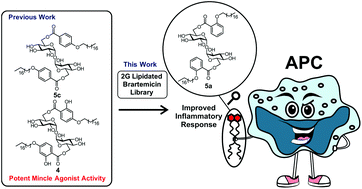ortho-Substituted lipidated Brartemicin derivative shows promising Mincle-mediated adjuvant activity†
Abstract
The macrophage inducible C-type lectin (Mincle) is a pathogen recognition receptor (PRR) that is a promising target for the development of Th1-polarising vaccine adjuvants. We recently reported on the synthesis and evaluation of lipidated Brartemicin analogues that showed Mincle agonist activity, with our lead agonist exhibiting potent Th1 adjuvant activity that was greater than that of trehalose dibehenate (TDB). Herein, we report on the efficient synthesis and subsequent biological evaluation of additional lipidated Brartemicin analogues that were designed to determine the structural requirements for optimal Mincle signalling. While all the Brartemicin analogues retained their ability to signal through Mincle and induce a functional response, the o-substituted and m,m-disubstituted derivatives (5a and 5d, respectively) induced a potent inflammatory response when using cells of both murine and human origin, with this response being the greatest observed thus far. As the inflammatory response elicited by 5a was slightly better than that induced by 5d, our findings point to o-substituted Brartemicin analogues as the preferred scaffold for further adjuvant development.



 Please wait while we load your content...
Please wait while we load your content...